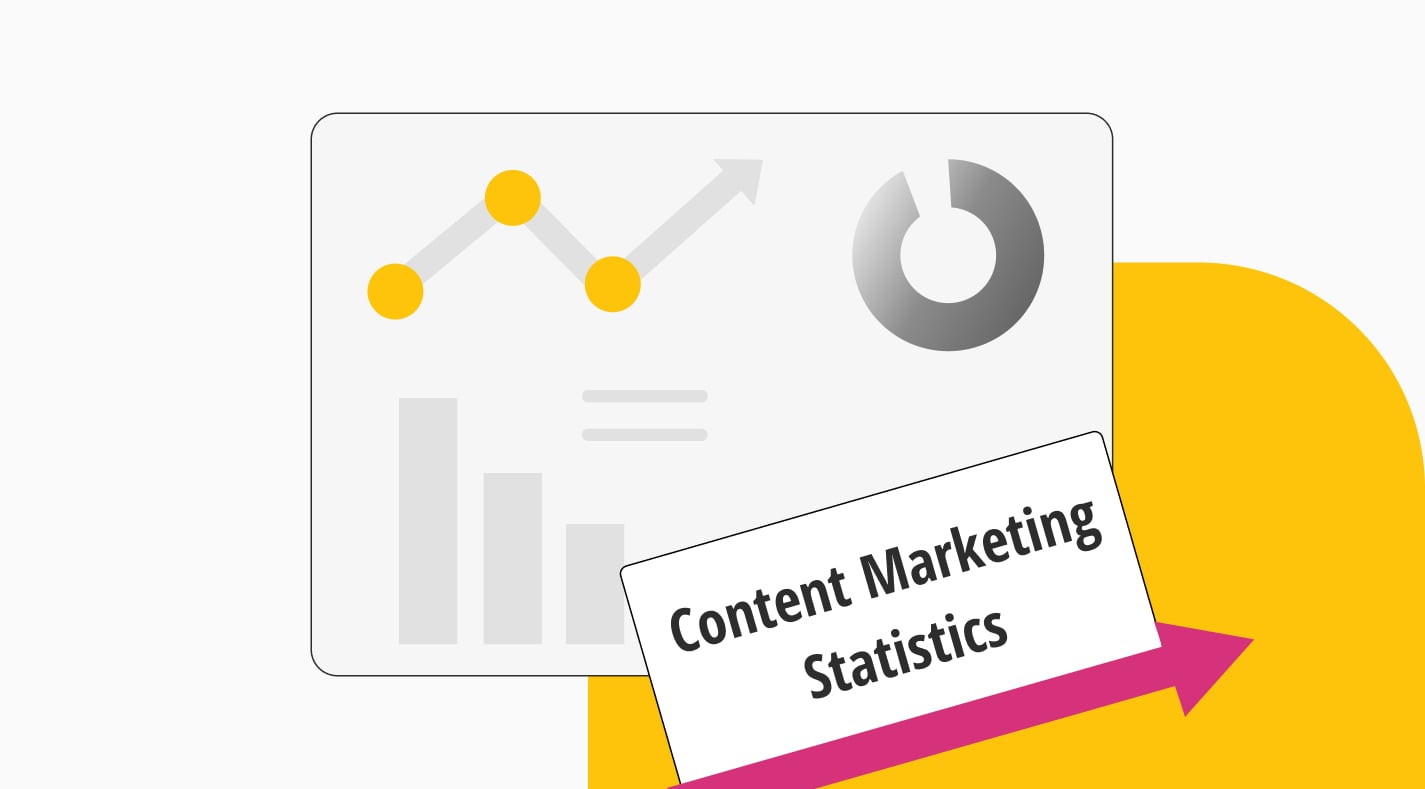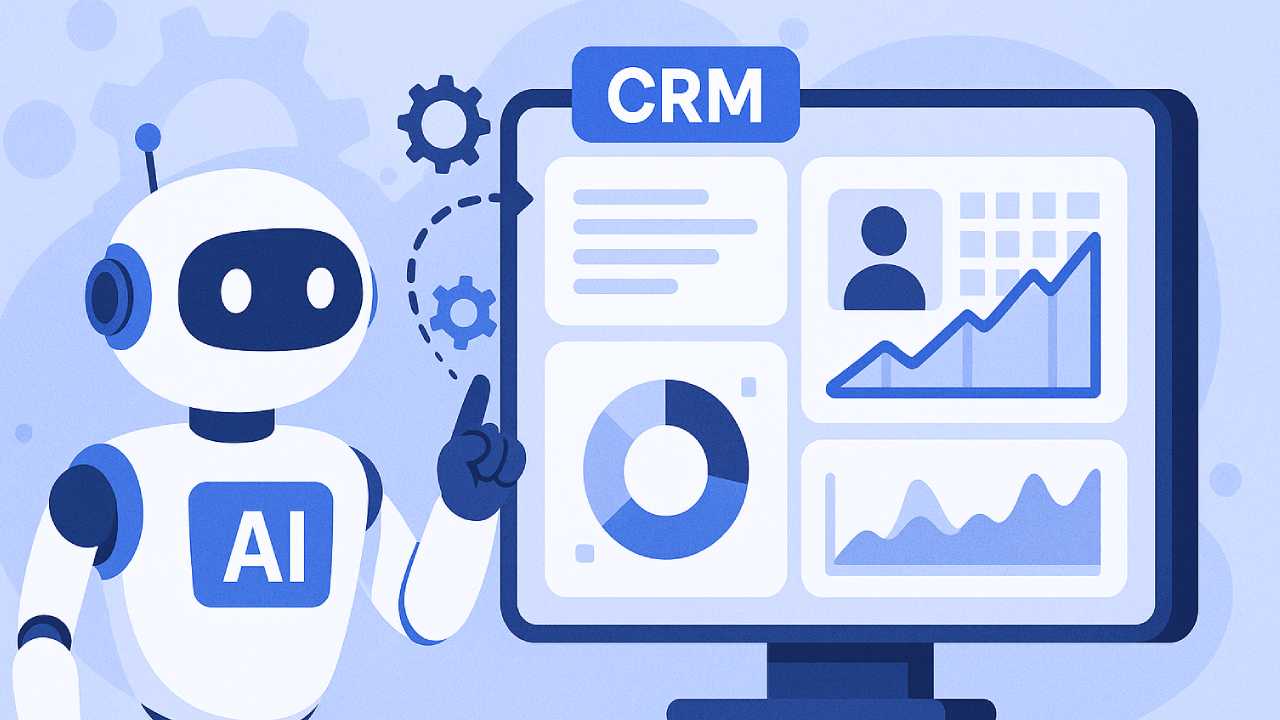In the dynamic digital landscape, understanding the current state and trajectory of content marketing is crucial for businesses aiming to connect with their audience and drive growth. The term “content marketing” itself has seen a nearly threefold increase in Google search interest over the last five years, highlighting its escalating importance. If you’re looking to harness the power of content marketing to boost your engagement, traffic, and ultimately, sales, staying informed with the latest data is non-negotiable. This compilation brings together key content marketing statistics for 2025, offering valuable insights into trends, spending, performance measurement, and return on investment (ROI). Dive into this data to refine your strategy and ensure your content marketing efforts are positioned for maximum impact in the year ahead.
Key Content Marketing Insights & General Trends
Understanding the foundational statistics provides a baseline for strategic planning. Here’s what the data reveals about current practices and outcomes:
1. Does consistent content creation impact traffic?
Absolutely. According to Semrush data, 55% of website owners experienced increased traffic by publishing content more frequently. Furthermore, 36% noted that focusing on thorough keyword research significantly contributed to improving their search engine rankings.
2. What is the typical monthly spend on content marketing?
Investment levels vary significantly. A Semrush survey indicated that 17% of marketers allocate between $5,000 and $10,000 monthly to content marketing, while 10% invest $10,000 to $20,000.
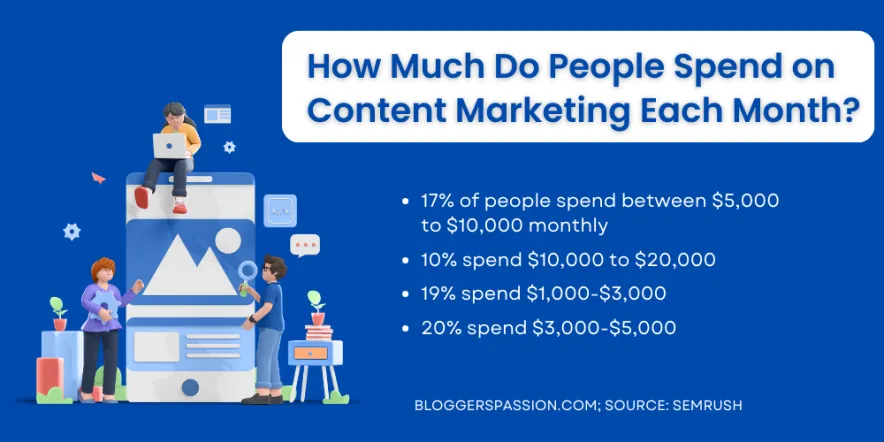 Chart detailing monthly content marketing spend percentages
Chart detailing monthly content marketing spend percentages
Here’s a more detailed breakdown of monthly spending habits:
- 27% spend less than $1,000
- 19% spend between $1,000 and $3,000
- 20% spend between $3,000 and $5,000
- 6% allocate over $20,000
3. How is content typically promoted?
Email marketing remains a primary channel, utilized by 53% of marketers for content promotion, as reported by Semrush. Other popular methods include:
- Organic social media posting (73%)
- Paid social media advertising (51%)
- Public relations (PR) and media outreach (28%)
- Guest posting (11%)
4. Are organizations measuring content performance?
Yes, a significant majority (75%) of organizations measure their content performance, according to the Content Marketing Institute (CMI). Among those who measure, 69% find website engagement metrics provide the most valuable insights into how their content is performing.
5. What tools are favored for visual content creation?
Visuals are critical in content marketing. Venngage research shows that 35.5% of marketers rely on dedicated image creation tools. Additionally, 28% have access to an in-house designer, and 18.7% utilize advanced design software like Adobe Creative Suite.
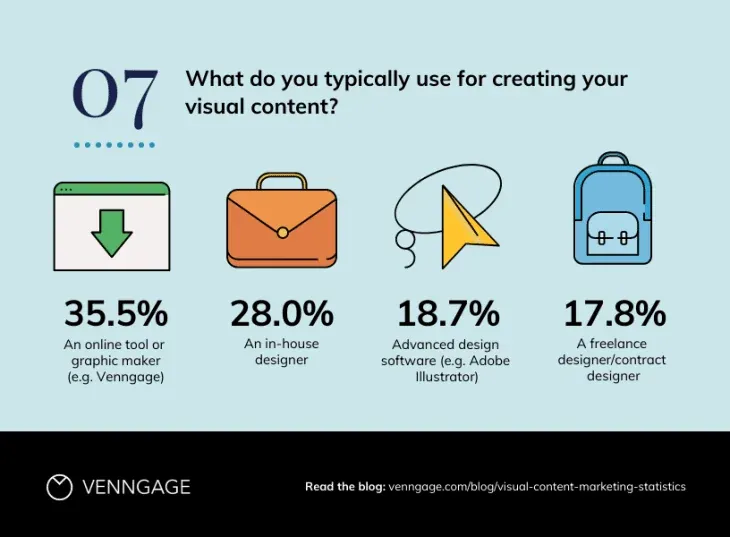 Pie chart illustrating the tools marketers use for visual content creation
Pie chart illustrating the tools marketers use for visual content creation
Statistics for Content Marketers
For those directly involved in creating and managing content, these statistics offer specific insights into challenges and practices:
1. What is the primary challenge for content marketers?
Finding adequate time for content creation and promotion is the biggest hurdle, cited by 52% of bloggers in an Orbit Media survey. Other significant challenges include:
- Generating sufficient traffic (46%)
- Consistently producing high-quality content (39%)
- Identifying relevant content topics (22%)
2. How long does it typically take to write a 1000-word article?
On average, crafting a blog post exceeding 1000 words takes approximately 3 hours and 46 minutes. Orbit Media notes that 17.5% of content creators dedicate more than 6 hours to complete a single article, emphasizing the time investment required for quality. AI writing assistants and hiring writers or editors are common strategies to manage this time commitment.
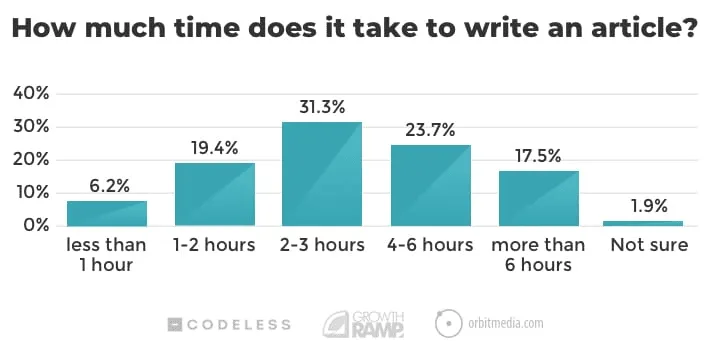 Graph showing the distribution of time spent writing a blog post
Graph showing the distribution of time spent writing a blog post
3. Which video formats yield the best results?
Short-form video (like YouTube Shorts, Instagram Reels, TikTok) currently leads in performance, favored by 43% of marketers surveyed by Semrush. Other effective video formats include:
- Company/product overview videos (33%)
- Customer success story videos (32%)
- Product demonstrations (29%)
- How-to videos (27%)
- Interviews with industry experts (25%)
4. What types of content are most commonly published?
How-to articles and comprehensive guides are the most prevalent content format, published by 76% of content creators, according to Orbit Media. Listicles (55%), interviews (34%), and roundup posts (22%) are also popular choices.
5. What is the average cost associated with producing an article?
Costs can vary based on depth and expertise. Media Shower suggests a basic 500-word article might cost around $50. A well-researched piece of the same length could be $100, while content requiring expert input might reach $250 per 500 words.
 Table comparing the cost per 500 words for basic, well-researched, and expert-level articles
Table comparing the cost per 500 words for basic, well-researched, and expert-level articles
B2B Content Marketing Data
Business-to-business (B2B) marketing requires a tailored approach. Here are statistics relevant to B2B content strategies:
1. How widespread is content marketing adoption in B2B?
Content marketing is a core strategy for many. The Content Marketing Institute reports that 73% of B2B marketers utilize content marketing. HubSpot corroborates this high adoption rate, stating that 82% of marketers overall actively invest in it.
2. Do B2B companies outsource content marketing tasks?
Outsourcing is common, particularly among larger organizations. CMI found that 75% of large companies outsource activities like topic research, content creation, editing, or promotion. Overall, 50% of all marketers, including 37% of small and 54% of medium-sized companies, outsource some aspect of content marketing.
 Illustration depicting hands passing content, symbolizing outsourcing in content marketing
Illustration depicting hands passing content, symbolizing outsourcing in content marketing
3. What are the top content marketing challenges for B2B?
According to Semrush, key challenges include:
- Attracting high-quality leads (45%)
- Creating content more efficiently (38%)
- Improving search engine rankings (29%)
- Producing original, high-quality content consistently (24%)
4. How effective do B2B marketers perceive their content marketing efforts?
CMI data indicates that 42% of B2B marketers consider their content marketing strategies to be effective. Success often hinges on a robust strategy focused on educating potential clients about products or services.
5. Is B2B content marketing spend increasing?
Yes, significantly. eMarketer reported that US B2B digital ad spending hit $15 billion last year. Projections for 2025 estimate B2B advertising spend in the US will approach $37.7 billion, indicating strong continued investment.
6. Do B2B buyers engage with content before purchasing?
Content plays a crucial role in the B2B buying journey. Research shows 47% of buyers consume three to five pieces of content before initiating contact with a sales representative. Furthermore, 96% seek insights from industry thought leaders prior to making a purchase decision.
B2C Content Marketing Statistics
Business-to-consumer (B2C) content marketing focuses on engaging individual consumers directly. Key statistics include:
1. Do B2C companies monitor their website traffic?
Yes, measuring organic traffic is a common practice, reported by 51% of B2C companies in a Semrush survey. Additionally, 19% track revenue generated from non-paid channels like word-of-mouth marketing.
2. Do B2C firms track lead generation from content?
A majority do. According to Semrush, 64% of B2C companies calculate the revenue directly attributable to their content marketing efforts.
3. Where are B2C companies focusing their content marketing investments?
Investment priorities revealed by Semrush include:
- Social media (57%)
- Improving content quality (45%)
- Customer research (36%)
- Video content creation (35%)
- Search engine optimization (SEO) (28%)
- AI content marketing tools (7%)
4. How prevalent is outsourcing in B2C content marketing?
Similar to B2B, outsourcing is common. CMI reports that 50% of B2C organizations outsource at least one content marketing activity.
5. What are the main challenges B2C companies face when outsourcing?
Budget constraints are the top issue, cited by 48% of B2C companies (CMI). Other significant challenges include finding content creators with subject matter expertise (47%) and identifying partners capable of providing strategic guidance (31%).
 Illustration showing a person juggling tasks, representing challenges in outsourcing content creation
Illustration showing a person juggling tasks, representing challenges in outsourcing content creation
6. What types of content are most frequently used by B2C companies?
Short articles and blog posts (83%) along with videos (61%) are the two dominant content types employed by B2C marketers, according to CMI.
7. Which B2C video formats deliver the best results?
CMI data shows that how-to videos (38%), interviews with industry experts (37%), and webinars (31%) are the top-performing video formats for B2C engagement. Interactive videos (13%), in-depth product reviews (12%), and industry research reports (7%) also yield positive results.
8. What content areas are considered most important moving forward for B2C?
B2C marketers are primarily focused on adapting to changes in search algorithms (64%) and social media algorithms (53%). Data management and analytics (48%) are also top priorities.
Understanding Content Marketing ROI
Measuring the return on investment is critical for justifying budgets and refining strategies. Here are stats focused on content marketing ROI:
1. Does content length impact performance?
Yes, significantly. Semrush analysis found that short-form content (300-900 words) attracts 21% less traffic and 75% fewer backlinks compared to articles of average length (900–1200 words). Longer, more detailed content generally performs better for traffic and link acquisition.
2. How important is SEO investment for marketers?
Extremely important. HubSpot states that 69% of marketers actively invest time and resources in SEO. Mastering SEO is fundamental for driving qualified traffic, leads, and conversions through content marketing.
3. Do images within blog posts contribute to backlinks?
Data suggests they do. Semrush reported that blog posts containing seven or more images generated 55% more backlinks than posts without any images. Utilizing original, high-quality graphics can enhance user engagement and attract more links.
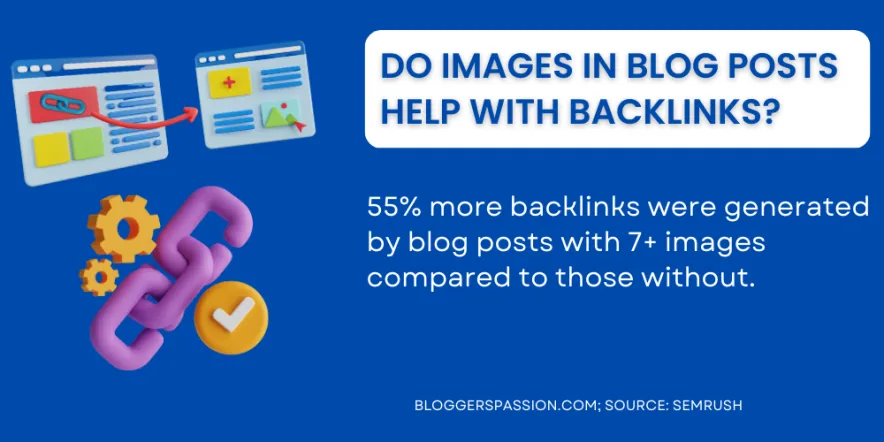 Chart comparing backlink generation for blog posts with varying numbers of images
Chart comparing backlink generation for blog posts with varying numbers of images
4. Does interactive content improve conversion rates?
Interactive content demonstrates higher engagement. According to MediaFly, it receives 53% more engagement than static content. Buyers spend an average of 13 minutes engaging with interactive content compared to 8.5 minutes with static content. Examples include quizzes, interactive infographics, calculators, and webinars.
5. How did the pandemic affect content marketing?
The pandemic significantly increased content consumption by 207%, as reported by MediaFly. Businesses utilizing interactive content experienced a remarkable 94% increase in content views during this period.
6. What are the key factors driving content marketing success?
A Semrush survey identified the top three factors for success as:
- Thorough audience research (47%)
- Effective SEO implementation (46%)
- Increasing content publication frequency (45%)
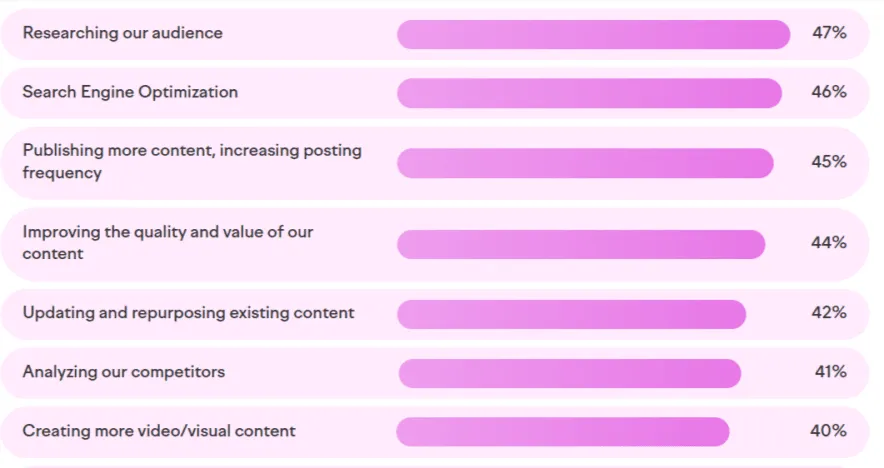 Diagram highlighting top success factors in content marketing: audience research, SEO, and posting frequency
Diagram highlighting top success factors in content marketing: audience research, SEO, and posting frequency
7. Which content formats demonstrate the best performance overall?
Video content leads the pack, cited as the best performer by 45% of respondents in the Semrush survey. Following video are:
- Short-form articles (31%)
- Customer success stories (28%)
- Long-form blog posts (24%)
- Case studies (19%)
- Webinars and online events (18%)
8. What are the top three most created types of content?
HubSpot reported that marketing teams primarily focused on creating videos, blog posts, and images over the past year.
9. Does updating existing content with new keywords improve rankings?
Yes, 45% of participants in the Semrush survey confirmed that researching and incorporating relevant secondary and LSI keywords into existing content helped improve search rankings.
10. What constitutes a good ROI for content marketing?
While ROI varies, many content marketers aim for a 5:1 ratio, meaning generating $5 in profit for every $1 spent on content marketing activities.
Noteworthy Content Marketing Facts for 2025
Beyond performance metrics, here are some interesting facts about the content marketing landscape:
1. What is considered the most potent content marketing tactic?
Email marketing consistently delivers high ROI. According to Litmus Report, it boasts an average ROI of $36 for every $1 spent, making it a highly effective tactic.
2. What percentage of marketers produce content daily?
Approximately 60% of marketers create at least one piece of content each day. This includes various formats like blog posts, videos, social media updates, podcasts, etc.
3. What is the estimated market size for content marketing?
The content marketing market is poised for substantial growth. Research and Markets projects it will expand by $584 billion between 2025 and 2027, reflecting a compound annual growth rate (CAGR) of 16%.
4. What is the global revenue of the content marketing industry?
Statista estimated the global content marketing industry revenue at $72 billion last year. Projections indicate it will reach $82 billion in 2025 and exceed $107.5 billion by 2026. This represents nearly a doubling of revenue since 2018 ($36.9 billion).
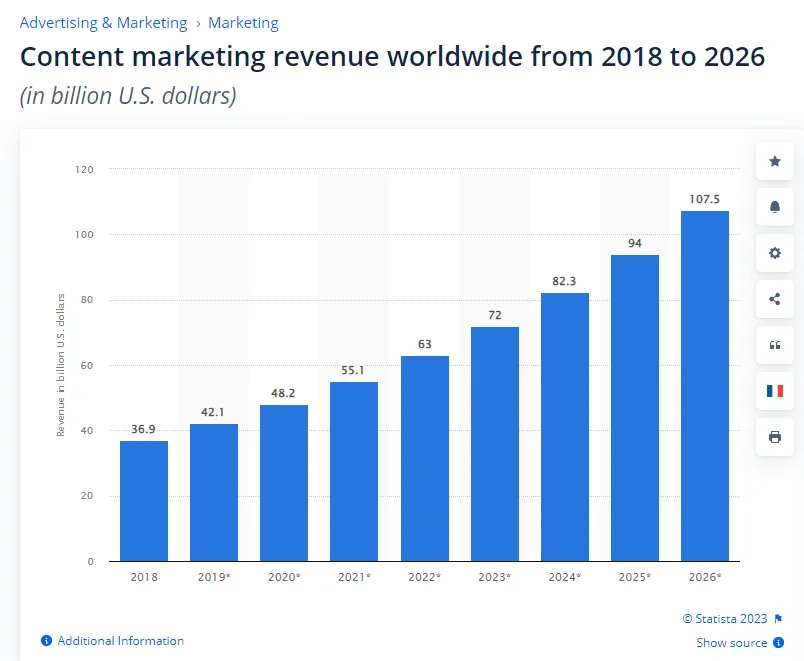 Graph showing the projected growth of global content marketing revenue from 2018 to 2026
Graph showing the projected growth of global content marketing revenue from 2018 to 2026
5. Is content marketing generally effective?
Data suggests a strong correlation between investment and success. 73% of companies allocating 10% to 70% of their total marketing budget to content marketing report being very successful.
6. Does using original graphics enhance marketing goals?
Yes. According to Venngage, 41% of marketers stated that original graphics, such as custom infographics and illustrations, were instrumental in helping them achieve their marketing objectives.
Frequently Asked Questions (FAQs)
Here are answers to common questions regarding content marketing statistics and trends for 2025:
What exactly is content marketing?
Content marketing is a strategic marketing approach focused on creating and distributing valuable, relevant, and consistent content (like blog posts, videos, podcasts, infographics) to attract and retain a clearly defined audience — and, ultimately, to drive profitable customer action.
What are key content marketing stats for 2025?
Key stats highlight the importance of video (especially short-form), the effectiveness of SEO, the rise in content marketing spend, the continued high ROI of email marketing, and the challenge of consistently creating high-quality content. For instance, 73% of B2B marketers use content marketing, and video is the top-performing format for 45% of marketers.
What is the typical ROI for content marketing?
Content marketing generally offers a strong ROI. It costs significantly less than traditional marketing (estimated 65% less) yet generates about three times as many leads. Many marketers aim for a 5:1 ROI ratio ($5 profit per $1 spent). B2B marketers with blogs, for example, gain 67% more leads than those without.
What does the future hold for content marketing?
The future of content marketing appears bright, driven by the increasing consumer demand for authenticity and valuable information. Trends point towards more personalized content, increased use of AI tools for creation and analysis, continued growth in video, and a greater emphasis on demonstrating E-E-A-T (Expertise, Experience, Authoritativeness, Trustworthiness). Adobe notes nearly 95% of consumers are more loyal to transparent brands, a trait built through quality content.
How much does creating an article usually cost?
Article costs vary widely based on length, research depth, and writer expertise. A basic 500-word article might cost $50-$75, while intermediate rates range from $125-$200. Expertly written, highly researched articles can cost $250 or more.
What are the main benefits of using content marketing?
The primary benefits include increased organic website traffic, improved lead generation and sales, enhanced brand awareness and credibility, stronger customer relationships and loyalty, and improved social media engagement.
Final Thoughts
Content marketing remains one of the most effective and cost-efficient strategies for businesses to engage audiences, build authority, drive traffic, and ultimately increase revenue. The statistics presented underscore its growing importance across B2B and B2C sectors, highlighting the need for a well-defined strategy that incorporates SEO, high-quality content creation (including video and potentially interactive formats), consistent publishing, and performance measurement.
As the data shows, success hinges on understanding your audience, investing appropriately (in time, resources, or outsourcing), and adapting to the evolving digital landscape. By leveraging these insights, you can refine your content marketing approach for 2025 and beyond. Consider exploring AI tools that can assist with research, creation, and optimization to further enhance your content marketing effectiveness.
